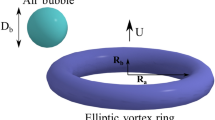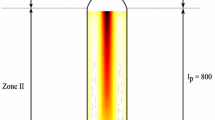Abstract
This experimental and numerical work explains why a vortex breakdown bubble first emerges and then disappears as the fluid rotation speeds up. To this end, we explore a flow in a sealed cylindrical container with one end disk rotating and all other walls stationary. The rotation drives the meridional circulation: the fluid filling the container moves away from the rotating disk along the sidewall, converges to the axis near the stationary disk, and goes back to the rotating disk near the axis. As the rotation speed Re increases, a cell of counter circulation—a vortex breakdown bubble (VBB)—emerges, expands, contracts, and disappears. On the (h, Re) map, the boundary of the VBB region consists of two branches, which meet and terminate at a fold point as h decreases (\(\mathrm{h} =H/R\), where \(H\) is the height and \(R\) is the radius of the cylinder). This study is the first to focus on the VB disappearance and explains the geometry of VBB region: why the VBB first emerges and then disappears as Re increases at a fixed h. In a few words, the mechanism is as follows. The convergence of the swirling flow to the axis reduces the pressure above the center of the stationary disk. Suction because of the reduced pressure creates a VBB and attracts it closer to the disk. This VBB shift deteriorates the flow convergence to the axis and concentrates the meridional circulation near the sidewall. The pressure grows above the still disk, the suction weakens, which kills the VBB, and the fluid stagnates near the axis. This mechanism is even more pronounced in a two-fluid flow.

















Similar content being viewed by others
REFERENCES
Peckham, D.H. and Atkinson, S.A., Preliminary Results of Low Speed Wind Tunnel Tests on a Gothic Wing of Aspect Ratio 1.0,Aero. Res. Council Tech. Rep. CP-508, TN no. Aero 2504, 1957.
Benjamin, T.B., Theory of Vortex Breakdown Phenomenon,J. Fluid Mech., 1962, vol. 14, pp. 593–629.
Shtern, V., Cellular Flows, New York: Cambridge Univ. Press, 2018.
Hall, M.G., Vortex Breakdown, Annu. Rev. Fluid Mech., 1972, vol. 4, pp. 195–218.
Leibovich, S., The Structure of Vortex Breakdown, Annu. Rev. Fluid Mech., 1978, vol. 10, pp. 221–246.
Leibovich, S., Vortex Stability and Breakdown: Survey and Extension, AIAA J., 1984, vol. 22, pp. 1192–1206.
Escudier, M.P., Confined Vortices in Flow Machinery Vortex Breakdown: Observations and Explanations, Progr. Aerospace Sci., 1988, vol. 25, pp. 189–229.
Keller, J.J., Egli, W., and Althaus, R., Vortex Breakdown as a Fundamental Element of Vortex Dynamics, Z. Angew. Math. Phys., 1988, vol. 39, p. 404.
Althaus, W., Brucker, C., and Weimer, M., Breakdown of Slender Vortices, in Fluid Vortices, Dordrecht: Kluver Academic, 1995, pp. 373–426.
Shtern, V. and Hussain, F., Collapse, Symmetry Breaking, and Hysteresis in Swirling Flows, Annu. Rev. Fluid Mech., 1999, vol. 31, pp. 537–566.
Lucca-Negro, O. and O’Donelly, T., Vortex Breakdown: A Review,Progr. Energy Combustion Sci., 2001, vol. 27, pp. 431–522.
Squire, H.B., Rotating Fluids, in Surveys in Mechanics, UK: Cambridge University Press, 1956, pp. 139–161.
Wang, S., and Russak, Z., The Dynamics of a Swirling Flow in a Pipe and Transition to Axisymmetric Vortex Breakdown, J. Fluid Mech., 1997, vol. 340, pp. 177–223.
Keller, J.J., Egli, W., and Althaus, R., Force- and Loss-Free Transitions between Flow States, Z. Angew. Math. Phys., 1985, vol. 36, p. 856.
Shtern, V., Hussain, F., and Herrada, M., New Features of Swirling Jets, Phys. Fluids, 2000, vol. 12, p. 2868.
Olendraru, C., Sellier, A., Rossi, M., and Huerre, P., Absolute/Convective Instability of the Batchelor Vortex, C. R. Acad. Sci. Paris, 1996, vol. 11b, p. 153.
Delbende, I., Chomas, J.M., and Huerre, P., Absolute/Convective Instabilities in the Batchelor Vortex: A Numerical Study of the Linear Response, J. Fluid Mech., 1998, vol. 355, pp. 229–254.
Gelfgat, A.Yu., Bar-Yoseph, P.Z., and Solan, A., Stability of Confined Swirling flow with and without Vortex Breakdown, J. Fluid Mech., 1996, vol. 311, pp. 1–36.
Gelfgat, A.Yu., Bar-Yoseph, P.Z., and Solan, A., Three-Dimensional Instabilities of Axisymmetric Flow in a Rotating Lid-Cylinder Enclosure, J. Fluid Mech., 2001, vol. 438, pp. 363–377.
Trigub, V.N., The Problem of Breakdown of a Vortex Line,J. Appl. Math. Mech., 1985, vol. 49, pp. 166–171.
Shtern, V., Counterflows: Paradoxical Fluid Mechanics Phenomena, New York: Cambridge Univ. Press, 2012.
Herrada, M.A. and Shtern, V.N., Patterns of a Creeping Waterspout Flow, J. Fluid Mech., 2014, vol. 744, pp. 65–88.
Shtern, V. and Hussain, F., Hysteresis in a Swirling Jet as a Model Tornado, Phys. Fluids A, 1993, vol. 5, pp. 2183–2195
Shtern, V. and Hussain, F., Hysteresis in Swirling Jets,J. Fluid Mech., 1996, vol. 309, pp. 1–44.
Vogel, H.U., Experimentelle Ergebnisse über die laminare Strömung in einem zylindrischen Gehäuse mit darin rotierender Scheibe, Bericht 6, Max-Planck-Institut für Strömungsforschung, Göttingen, 1968.
Escudier, M.P., Observations of the Flow Produced in Cylindrical Container by a Rotating Endwall, Exp. Fluids, 1984, vol. 2, p. 189–196.
Lopez, J.M., Axisymmetric Vortex Breakdown, Part 1. Confined Swirling Flow, J. Fluid Mech., 1990, vol. 221, pp. 533–552.
Husain, H., Shtern, V., and Hussain, F., Control of Vortex Breakdown by Addition of Near-Axis Swirl, Phys. Fluids, 2003, vol. 15, pp. 271–279.
Shtern, V., and Borissov, A., Counterflow Driven by Swirl Decay, Phys. Fluids, 2010, vol. 22, p. 063601.
Shtern, V., and Borissov, A., Nature of Counterflow and Circulation in Vortex Separators, Phys. Fluids, 2010, vol. 22, p. 083601.
Shtern, V.N., Torregrosa, M.M., and Herrada, M.A., Development of a Swirling Double Counterflow, Phys. Rev. E, 2011, vol. 83, p. 056322.
Shtern, V.N., Torregrosa, M.M., and Herrada, M.A., Development of Colliding Counterflows, Phys. Rev. E, 2011, vol. 84, p. 046306.
Shtern, V.N., Torregrosa, M.M., and Herrada, M.A., Effect of Swirl Decay on Vortex Breakdown in a Confined Steady Axisymmetric Flow, Phys. Fluids, 2012, vol. 24, p. 043601.
Mununga, L., Lo Jacono, D., Sørensen, J.N., Leweke, T., Thompson, M.C., and Hourigan, K., Control of Confined Vortex Breakdown with Partial Rotating Lids, J. Fluid Mech., 2014, vol. 738, pp. 5–33.
Tsai, J.C., Tao, C.Y., Sun, Y.C., Lai, C.Y., Huang, K.H., Juan, W.T., and Huang, J.R., Vortex-Induced Morphology on a Two-Fluid Interface and the Transitions, Phys. Rev. E, 2015, vol. 92, p. 031002(R).
Sørensen, J.N., Gelfgat, A.Y., Naumov, I.V., and Mikkelsen, R., Experimental and Numerical Results on the Three-Dimensional Instabilities in a Rotating Disk-Tall Cylinder Flow, Phys. Fluids, 2009, vol. 21, p. 054102.
Sørensen, J.N., Naumov, I.V., and Mikkelsen, R., Experimental Investigation of Three-Dimensional Flow Instability in a Rotating Lid-Driven Cavity, Exp. Fluids, 2006, vol. 41, pp. 425–440.
Naumov, I.V., Herrada, M.A., Sharifullin, B.R., and Shtern, V.N., Hysteretic Growth and Decay of a Waterspout Column,Phys. Rev. Fluids, 2018, vol. 3, p. 024701.
Kármán, T., Über Laminare und Turbulent Reibung,Z. Angew. Math. Mech., 1921, vol. 1, pp. 233–252.
Herrada, M.A., Shtern, V.N., and Torregrosa, M.M., The Instability Nature of the Vogel–Escudier Flow, J. Fluid Mech., 2015, vol. 766, pp. 590–610.
Shtern, V., and Hussain, F., Effect of Deceleration on Jet Instability, J. Fluid Mech., 2003, vol. 480, pp. 283–309.
Shtern, V., Mechanisms of Jet Instability: Role of Deceleration, Fluid Dynamics Res., 2018, vol. 50, p. 051408.
Naumov, I.V., Herrada, M.A., Sharifullin, B.R., and Shtern, V.N., Slip at the Interface of a Two-Fluid Swirling Flow,Phys. Fluids, 2018, vol. 30, p. 074101.
Naumov, I.V., Glavny, V.G., Sharifullin, B.R., and Shtern, V.N., Formation of a Thin Circulation Layer in a Two-Fluid Rotating Flow, Phys. Rev. Fluids, 2019, vol. 4, p. 054702.
Moffatt, H.K., Viscous and Resistive Eddies near a Sharp Corner, J. Fluid Mech., 1964, vol. 18, pp. 1–18.
Herrada, M. A., Shtern, V.N., and López-Herrera, J.M., Vortex Breakdown in a Water-Spout Flow, Phys. Fluids, 2013, vol. 25, p. 093604.
Naumov, I.V., Kashkarova, M.V., Mikkelsen, R.F., and Okulov, V.L., Structure of the Confined Swirling Flow with Different Phase Boundary Conditions at the Fixed End of the Cylinder,Thermohys. Aeromech., 2019 (submitted).
Funding
This research was supported by the Spanish Ministry of Economy, Industry and Competitiveness (grant DPI2016-78887). The experimental part of this study was supported by Russian Science Foundation, grant no. 19-19-00083.
Author information
Authors and Affiliations
Corresponding author
Rights and permissions
About this article
Cite this article
Carrion, L., Naumov, I.V., Sharifullin, B.R. et al. Mechanism of Disappearance of Vortex Breakdown in a Confined Flow. J. Engin. Thermophys. 29, 49–66 (2020). https://doi.org/10.1134/S1810232820010051
Received:
Revised:
Accepted:
Published:
Issue Date:
DOI: https://doi.org/10.1134/S1810232820010051




